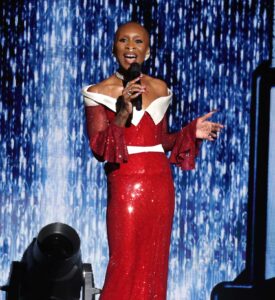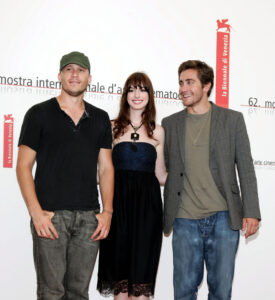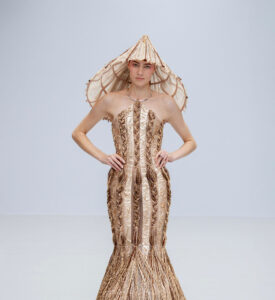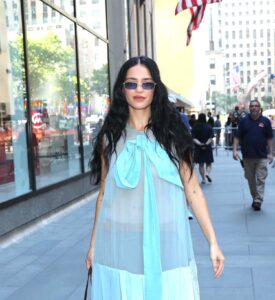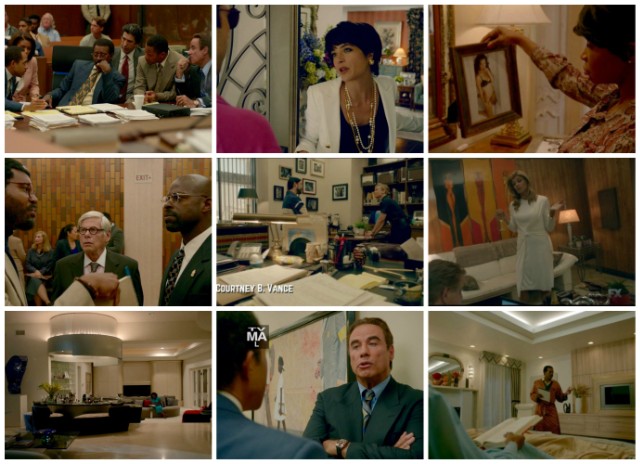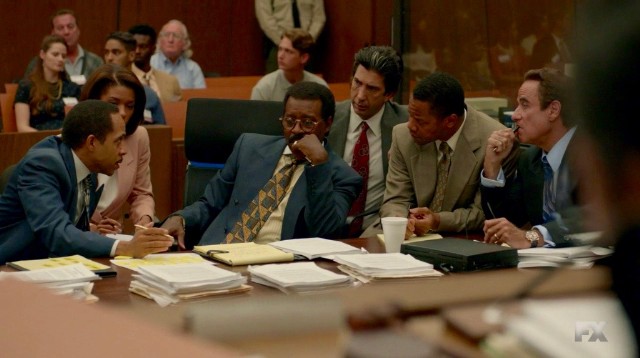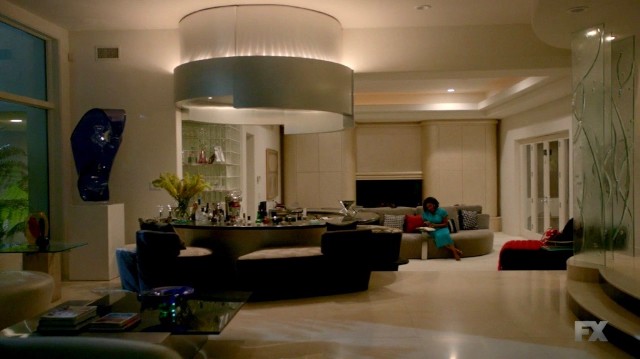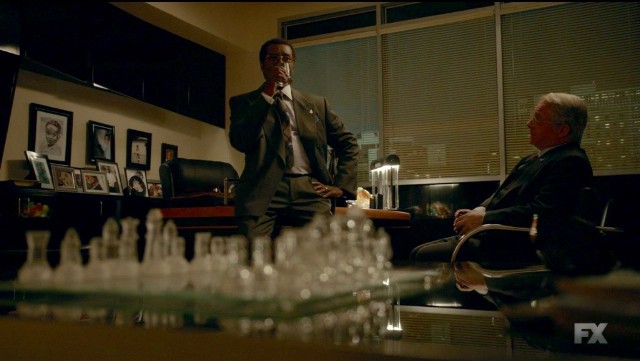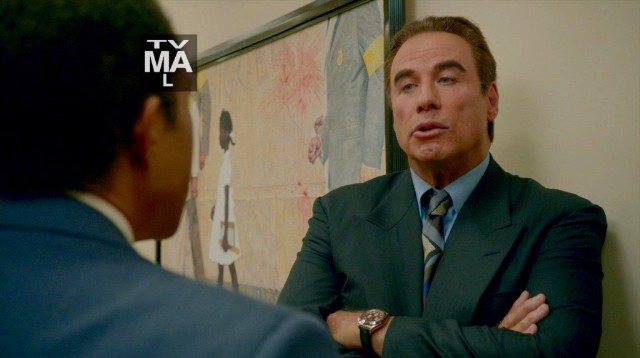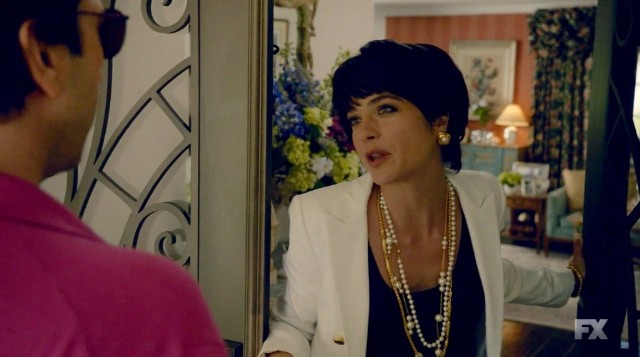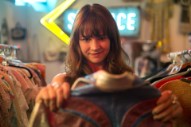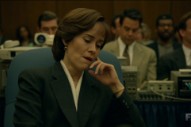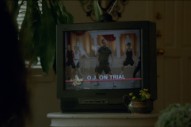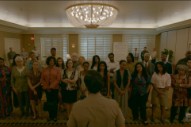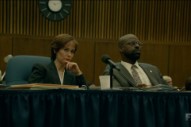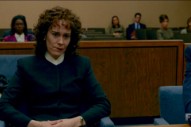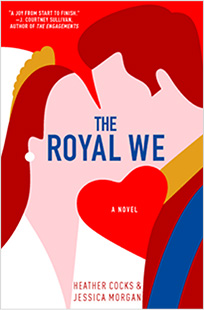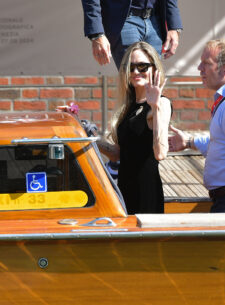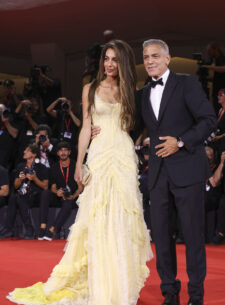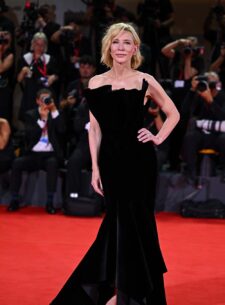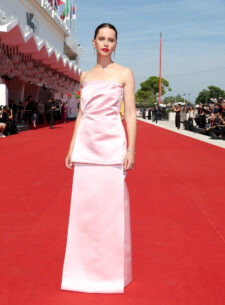If you’ve been watching American Crime Story: The People vs OJ Simpson – or reading our recaps — you’re well aware that the show is so excellent in part because it’s tremendously good at transporting the viewer back to mid-90s Los Angeles. From the music supervisors to the lighting designers, everyone was really firing on all all cylinders. And one of my personal favorite aspects of this show is its sets. Whether we’re talking about the inside of Judge Ito’s courtroom, or the French Country shabby chic of Robert Shapiro’s bedroom, they are perfect. So, as you can imagine, we were very pleased to get to exchange some emails with Jeffrey Mossa, the show’s production designer, and Amber Haley, its set decorator, about how they made the magic happen — and how “weird stalker websites helped,” what’s going on with Johnnie’s actual office, and where, exactly, furniture from the 80s and 90s Beverly Hills goes to die.
GFY: Could you give us some background on how you got involved in set/production design? (And what is the difference between the two?)
JEFFREY: I had a passion for drawing from age four. I used to draw Darth Vader, R2D2, and Yoda, and make posters and album covers for my favorite bands. After seeing Raiders of the Lost Ark, I decided I wanted to be Indiana Jones. Since I couldn’t travel back in time and become an archaeologist, and since I knew I was a decent artist, I thought maybe I could work as an artist in movies. When I was in seventh grade, I saw a TV special on Industrial Light and Magic — it showed all the special effects technicians, model makers, and creature technicians from Star Wars, Raiders of the Lost Ark, Ghostbusters, etc. I was hooked. At the time, I thought I wanted to get into special effects. In high school, we had a drama club, but I wanted nothing to do with that. We also had the “Spring Spectacular,” which was essentially a big variety show full of acts from various Broadway musicals. I started designing and building the sets for those freshman year and never looked back. Several of the teachers were impressed with my work ethic. One of them, a counselor that was actually never assigned to me, sought me out and recommended I apply to the Boston University Theatre Design program. I took his advice and began a journey that continues to this day.
As far as the difference between a set designer and production designer, it can vary depending on the medium. For example, in theater, the set designer is the person who (obviously) designs the sets. In film and television, there’s generally a larger scope of work going on, so you need more hands, and a bigger department. So the Production Designer is responsible for the look of all of the sets, set dressing, and props. It’s a huge job and you need a highly skilled and talented team to help you. So the set designer is the person who actually does the working draftings for the sets. We had a few set designers on TPVOJ, but our constant was Betty Krul. Betty is fantastic, she and I have an amazing shorthand, and I trust her. Betty is very talented, so I can trust her to work out the finer details of the set and get them right. This is not always the case, but in a situation where the two positions have a great working relationship, the set designer will definitely contribute to the aesthetic. Just to be clear on what I said earlier, as production designer I am responsible for set dressing and props, but both the prop master and the set decorator bring their aesthetic as well. Amber did an amazing job decorating the sets. We were able to have very brief but important discussions about each set before she shopped them, and we refined them together. Both of these positions are big jobs with big responsibilities.
AMBER: The designer is responsible for the overall look. They come up with the concept for the space. The set decorator, my role, provides all the details (e.g., furniture, drapery, artwork, and all the “stuff” that makes the space look real…i.e,. anything not nailed down). This texture helps provide the backstory of the characters and give life to the set. My mother was an interior designer, so I was exposed to art and aesthetics. I also grew up in La Jolla, California, at a time when it was transitioning from a sleepy beach town into a very affluent area. At an early age, I was able to identify a family’s backstory (old money, new money, renting/owning) and political leaning based on how they furnished their homes. But I kind fell into show business. I was working as a graphic designer for the Golden Door Spa in San Diego. A friend of a friend asked if I wanted to visit his commercial set. I did, and I loved it. That’s when I knew what my passion was. I first worked on a few commercials, then on a movie that came to San Diego. That led to a job in Los Angeles. I had the good fortune of working as a shopper for some phenomenal decorators.
GFY: How did you get involved with this project specifically?
JEFFREY: I was approached by the line producer, Chip Vucelich, who is someone I had worked with a couple of times prior. Chip has been a great friend and colleague, and has been a champion of mine in a business where many folks can be hesitant to stick their necks out for someone.
AMBER: A producer that I had worked with previously recommended me to Chip Vucelich.
GFY: Could you take us through a typical day at the office? I’m sure it varies at different points in production. What are some of the major duties that you have during a project, and at what point in pre-production do you come on board? Are you putting out day-to-day fires during the shoots, too, or are you always looking ahead to the next episodes?
JEFFREY: There is no typical day at the office. I think that what makes doing what we do appealing. The days do change dramatically depending on what point we are at in production, and also, each project is very different. I am one of the first people they hire – very early on in the process. Creating the permanent sets and scouting for the major locations takes time, so they generally bring me in anywhere from 6 to 9 weeks ahead of shooting.
We try like hell not to have to put out fires on “the day of” on set. Our job is to be two or three steps ahead of everyone else. Communication is key. Emergencies do occur, but we have a talented professional staff that specializes in knocking curveballs out of the park. Any time the shooting company arrives at a new set for the first time, Amber and I will “Open Set” – which means everything is done and looks amazing. We generally stay long enough that the director and actors have had time to rehearse the scene. If we’ve done our jobs right, everyone is happy, they finish rehearsal and we get the hell out of dodge because we’ve got a bunch more sets to get ready. We don’t hang around while they’re shooting except in specific instances when an element of the set needs to change mid-shooting. If we’ve really done our job well on location, most of the shooting company doesn’t even realize the work we’ve done. They often think it was like that before we got there.
And, yes, we are ALWAYS looking ahead. Often looking further ahead than the producers – which, most of the time, is greatly appreciated by them.
AMBER: During prep (before filming), it’s mostly finding all the right items — whether it’s at prop houses, furniture stores, thrift shops, and even scouring online for the perfect pieces. Some days you are driving all around LA, other days you have production meetings, location scouts, and meetings with the director. Budgeting is a huge part of this job. You have to determine whether to buy or rent, because no matter what the project is, there are financial constraints. Right before the shooting starts, you then shift into a phase of pulling it all together, creating something that tells the story.
GFY: How much freedom do you have to make artistic decisions? Does everything have to be signed off on, or do you have creative latitude? (I’m sure this probably also varies from production to production.) We’d love to hear how the vision for this kind of show gets hammered out.
JEFFREY: As far as artistic freedom, that can vary dramatically depending on the personalities involved. This is a collaborative art — which is what makes it great. Having said that, if they hire you, they are buying into a certain amount of trust in your style and aesthetic. They don’t have the time to sweat the details like we do, so ultimately we bring a lot to the table. When designing the architecture of the sets, I have to consider the blocking of the scene and staging of actors and camera, so, yes, before we start building I generally seek a buy-off from the director and producers for the basic ground plan of the sets. Depending on the sets, I will also provide research reference and even a perspective rendering of the proposed set. This may or may not include swatches of fabric and paint chips – again, each situation is different. Ryan Murphy is very clear — if he doesn’t like something you show him, he’ll let you know.
The vision for this show starts with research. LOTS and LOTS of research. Some of which was really not easy to come by. And there tend to be a LOT of gaps to fill in. Francesca Galesi is a researcher I’ve used in the past, and she was tremendous help finding nuggets of research in the beginning that I would never have found on my own. Maren Brown, our art department coordinator, was also massively involved in the research throughout the whole project. I’d never have survived without her tireless efforts.
The vision then evolves, of course — whether it’s to make things more cinematic, or to take the edge of of some of the more garish 90’s details that would distract the contemporary viewer from the scene. The DA’s office, for instance, had all the surfaces and architectural details off the real thing, but we reformatted the layout to make it more cinematic.
AMBER: I have a lot of creative freedom. But you don’t want to surprise anyone on the day of shooting. For that reason I take photos of everything I plan to deliver to the set.
GFY: When you’re working on something like TPVOJS, and creating a set based on actual places, how close do you try to get to the actual place? (I’m actually not sure which sets in this project are locations, and which have been recreated. The courtroom, for example, is SO DEAD ON that I would bet it’s a location — but that seems unlikely to have been allowed.)
JEFFREY: The degree of accuracy varies, and the degree to which accuracy was desired varied. The crime scene needed to be exact. I was counting tiles in the photos, coming over every little detail to match it perfectly. The interior of Nicole’s condo, however, was less exact and captured the essence of the real thing. This was partly driven by the needs of the shooting schedule and having to find a location near our exterior that would work. Brad (Simpson) and Nina (Jacobson, the executive producers) felt that since everyone remembers the crime scene walkway, we couldn’t mess with that. The interior of the condo, almost nobody would remember that.
The courtroom, and the court hallway are sets. That was a decision form the get go.We were going to be doing so much shooting in there, we needed to build them. The divorce court and the prelim court are locations. Those were one time shoots.
I was able to walk into the real courtroom while it wasn’t in session. I took hundreds of measurements as fast as I could, and, while I wasn’t supposed to, I was able to take several photos of even the tiniest details of the real thing, which we replicated in painstaking detail. When the cast was all in the set on the first day we were shooting it, I felt like I was no longer in a set and had stepped back in a time machine.
AMBER: That’s right, the courtroom is a set. Jeff did such a good job building that set, I would sometimes forget I was not downtown.
GFY: How do you go about recreating actual spaces? What kind of research do you do?
JEFFREY: Research, research, research. Find whatever you can, however you can. Google, Getty, Flikr, old magazines, weird stalker websites — it’s all fair game. We toured the real criminal courts building. We surveyed and measured the floor immediately below the floor of Johnnie Cochran’s real office. His real office is supposedly still intact as a makeshift “shrine” — but we were told not to contact them.
For Johnnie’s house, we found a photo of the outside and a picture of him in his living room – limited details, but we took those, ran with them and filled in the gaps. I had one shot of Johnnie in his office, and found myself looking in the reflection of the cabinet doors to determine what the rest of the room looked like behind where the camera took the picture. For Marcia’s house, we had footage of her getting in her car in her driveway and were able to get a sense of what the house was like.
GFY: Where do you source props for a period piece like this? It seems like it would be a different assignment to recreate 1994 than, say, working on something like Mad Men (or Deadwood, or something like Game of Thrones).
JEFFREY: Amber and Dwayne (our prop master) could answer this better than I — there are several prop houses in town, many of whom will manufacture a period piece for you if they don’t have it. The internet is also a wondrous source for many things of old.
AMBER: We actually sourced many items from eBay. There are many good prop houses where you can find great stuff. For this show, I used Omega Cinema Props, Object, and Warner Brothers quite a bit. We also found many gems in consignment shops in and around Beverly Hills. As my shopper Rebecca Keeling would say, “This is where all the furniture from the 80s and 90s Beverly Hills comes to die.” When when you are dressing for a particular decade, you have to include furnishing from prior decades, because of course no has entirely new furniture in their home.
GFY: Which sets were your favorites — and, in fact, which little details were the ones you were proudest of getting right? Which were the hardest?
JEFFREY: I think I change favorite sets as I watch the series again. Shapiro’s home study and Johnnie’s bedroom were some of my favorites while we were working on it. Mostly because those were completely built sets with no real reference, so we created those from scratch. How could you not love the courtroom? I’m so happy that our directors and Nelson (our DP) shot that the way they did. It’s the courtroom you know, but you’ve never seen it like this – it makes you feel you’ve got the inside track with the lawyers. I’m also fond of the jail set. It’s not the prettiest thing in the world, but that’s what ’s great about it — it really puts OJ in a place he clearly cannot deal with. The DA’s office shoots great — you don’t feel like you’re in a set at all. Honestly I’m proud of it all and thrilled at how well the look of the show is being received.
GFY: We noticed the chess sets in each legal office. Can you talk about how you decided on that detail, and how you even picked which chess pieces went to which person? Are there any other fun little set/production Easter eggs in there like that? (And did anyone ever actually move the chess pieces from episode to episode?)
JEFFREY I’m not sure who decided on the chess sets. I think it was Bob Gould, the first decorator. We certainly ran with it, and it made sense. I actually thought about how cool it would be if we moved the pieces in a very specific way as the series went on. That quickly became a pipe dream as our shooting schedule started coming of the rails a bit in the middle of episode 5, and we began radically shooting out of order. It would have been impossible to track. There were weeks where we were shooting three or four episodes — and in the end we had days like that.
They aren’t really any other “Easter eggs” per se. We did expand on Shapiro’s boxing theme. He was a boxer – so we ran with that and reflected it in sculpture and paintings. Amber got great boxing paintings for his home study.
GFY: Could you talk about the scene where Johnnie’s team totally strips down OJ’s place and redecorates it? What is the experience like of essentially having to create two versions of one set? And how precise did you and the props folks have to be with some of those things? For example, OJ’s Heisman. Did you commission that? We only really saw it from the back, I think. Was it completely finished or just from the one angle?
JEFFREY: The Heisman is a prop that’s probably in a few prop houses in LA. (Amber can correct me if I’m wrong.) I don’t think that was overly difficult. Redecorating that house was not easy — not gonna lie. That is a good example of every photo and piece of art needing be bought off on. Lots of opinions to consider. So it was a process — and there are legal clearances involved was well. That was a thorn in our side for weeks. That’s also an example of when we had to hang around set a bit longer than usual.
GFY: In Episode 5, the painting “The Problem We All Live With” features prominently. Was that a historically accurate detail, or something you guys came up with to convey a particular message? (It appears behind Shapiro early on, and then Cochran hangs it in OJ’s house.) What subtle touches did you guys add to convey mood, or message, in a show like this which is depicting such a complicated racial and social landscape?
JEFFREY: That painting was decided on very early on. That detail came straight from the script and honestly I can’t speak to whether or not that detail is accurate. It’s poignant and perfect though isn’t it?
We were definitely aware of what the art and decor conveyed about the characters and race. We didn’t overthink it, but certainly it came into play. I’m not sure that we paid more attention to that, though, than we would in any other even fictitious script as we help to define the characters by their surroundings.
GFY: Both of you have done a lot of work on contemporary pieces — was it difficult to switch over to a period piece? I have to tell you that, having lived here in Los Angeles in 1994 (and my whole life), I don’t know if I’ve ever seen a show that captured LA in the 90s in such a naturalistic and accurate way.
JEFFREY: I don’t think it’s that difficult to adjust to the period of it all. We always start with research, whether or not its a period piece. So while it can present some challenges, the process is generally the same. I’m glad you feel it’s authentic — it means we did our job well. The worst thing would be you being distracted from a scene because the setting didn’t ring true.
AMBER: It just takes a lot more time and resources to accurately depict an era as opposed to present day. But either way we do a lot of research. It’s harder to find correct pieces for a period project.
GFY: What was your biggest challenge on this project? Related, is there anything you WANTED to do, but weren’t able to?
JEFFREY: Honestly the single biggest challenge was dealing with the logistics of the schedule. Ryan Murphy was running three shows, directing for two of them, and we had plenty of actor and location schedule issues to work around. So, really, the hardest part was keeping morale and reacting to curveballs. The other aspects of the show ere by no means easy, but they were better defined.
There’s always things I wanted to do but couldn’t — I can’t think of anything specific on this project right now, I guess I’m far enough removed from it.
GFY: Is there anything you wish you could go back and do differently, or fix?
JEFFREY: I have to say I’m happy with the sets — I love the way they’ve shot them. I wouldn’t have done much differently. In episode 4, when Robert Kardashian goes to pick up his kids and Kris Jenner answers the door, that was a location we found that had to be near the house we were shooting for Johnnie’s house. So it wasn’t quite the right look, and it really wanted to be a two-story house. We did quite a bit of landscaping and decorating to bring the house “up” — but we also planned to add a second story via visual effects in post. We did all the design work for that and passed it along, but it’s clear the producing corps decide not to spend that money, as it didn’t make it to the screen. I think I’m the only person who missed it though! Nobody cried foul.
GFY: Do you watch these episodes as they air, or would that just drive you crazy?
JEFFREY: I actually don’t have cable, so I have to watch them on iTunes, which means I watch them the next day. I really enjoy watching them. I’m totally engrossed in the characters. That is a sign of success for me — when I can forget about my work and just enjoy the show in (almost) the same manner you do. It’s my goal to have that experience on every show I work on.
AMBER: Yes! Fortunately unlike actors, we don’t have to rely on a few takes. By the time it get’s shot, we’ve spent considerable time on it. So usually it’s more appreciation of how it all came together. It’s actually quite enjoyable to watch.
GFY: What is your dream project?
JEFFREY: My dream is to work on material that I want to watch. It’s really that simple. I love telling stories — if I respond to it, it’s perfect. I’ve had the fortune of working with some top notch talent — what more could you ask for? (Maybe an Emmy? 😉 )
AMBER: Well, I have an eleven year old son, so it’s not working on something out of town. My husband and I watch a lot of HBO shows, so I’d really like to work on one of those series. But I don’t really have specific types of things I want to work on. I enjoy the variety that this business brings.
GFY: And finally, if it hasn’t come up yet: Where were YOU when the OJ Simpson chase happened, and during the trial and the verdict? Were you as glued to it as everyone else? What are your memories of this time, and did any of them inform your work here?
JEFFREY: I first moved to LA in the fall of 1993. The Northridge earthquake was my first earthquake. I was headed to LAX to fly home to see family the day of the slow speed chase. I remember all the helicopters in the sky. I got the airport just before things got real. I certainly paid attention to the trial, but I wouldn’t say I was glued. I’d check in every now and then.
GFY: Is there anything else you want to mention that we haven’t covered? Thank you SO MUCH for taking the time to talk to us!
JEFFREY: It takes a village to pull this off, and I had the privilege of having an incredibly talented small army working with me to make everything amazing. On something like this, you are certainly in the trenches with these people on their, and your, best and worst days. It may sound cliche, but I couldn’t have done it without them and am extremely grateful. So while I’d like to take a heaping spoonful of credit, I am one man who is nothing without them. Whether it’s Amber, Maren, Betty, Gary Christensen (our construction coordinator), Scott Cobb (my art director), Lori West (our graphic designer), Rob Tokarz (our assistant art director), Joe Samuelson (our art dept PA), and the countless others who worked with and for all those folks, their efforts should be celebrated. Not only are they all incredibly talented individuals, I’m fortunate enough to count them all as friends.
AMBER: I personally want to thank Jeff for being such a focused, smart and funny leader. He raised all of our games. I need to thank my tireless crew: Rebecca Keeling (shopper), Keith Alshire-Rezendez (leadman, who’s responsible for the set dressers and logistics), Gio Aurilia (on-set dresser), and finally Nya Patrios (a fellow decorator), who is also a yogi and having her energy around us daily was a blessing.
Did you enjoy this? You might also enjoy our interview with Kristin Burke, Sleepy Hollow’s original costume designer.
